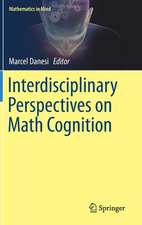The Puzzle Instinct – The Meaning of Puzzles in Human Life
Autor Marcel Danesien Limba Engleză Paperback – 19 feb 2004
Preț: 138.69 lei
Nou
Puncte Express: 208
Preț estimativ în valută:
26.54€ • 27.78$ • 21.96£
26.54€ • 27.78$ • 21.96£
Carte disponibilă
Livrare economică 15-29 martie
Livrare express 04-08 martie pentru 26.44 lei
Preluare comenzi: 021 569.72.76
Specificații
ISBN-13: 9780253217080
ISBN-10: 0253217083
Pagini: 288
Dimensiuni: 168 x 227 x 16 mm
Greutate: 0.4 kg
Editura: MH – Indiana University Press
Locul publicării:United States
ISBN-10: 0253217083
Pagini: 288
Dimensiuni: 168 x 227 x 16 mm
Greutate: 0.4 kg
Editura: MH – Indiana University Press
Locul publicării:United States
Cuprins
1. Why Puzzles?; 2. Puzzling Language: Riddles, Anagrams, and Other Verbal Perplexities; 3. Puzzling Pictures: Optical Illusions, Mazes, and Other Visual Mind-Bogglers; 4. Puzzling Logic: Deductions, Paradoxes, and Other Forms of Mind Play; 5. Puzzling Numbers: Magic Squares, Cryptarithms, and Other Mathematical Recreations; 6. Puzzling Games: Chess, Checkers, and Other Games; 7. The Puzzle of Life; Solutions; Bibliography and General Reading List
Recenzii
Danesi, a professor of semiotics and anthropology (Univ. of Toronto), explores why puzzles, having arisen in earliest human history at the same time as mystery cults, are an intrinsic part of human life. Will Shortz, crossword puzzle editor of the New York Times, has suggested enigmatology as the study of the relationship between puzzles and culture. This book, which explores the puzzle genres that have survived over the years, is a contribution to that rubric. After first asking the question Why puzzles? (and developing several possible answers, among which is that they provide comic relief from unanswerable larger questions), Danesi devotes chapters to each of several types of puzzle. These include language puzzles (e.g., riddles and anagrams); pictures (e.g., optical illusions and mazes); logic (e.g., deductions and paradoxes); numbers (e.g., mathematical recreations); and games (e.g., chess). A final chapter synopsizes the discussion. A detailed list of references is included, as are solutions to the specific puzzles posed. The book is well written, has no mathematical prerequisites, and is quite suitable for a general audience as well as lower- and upper-division undergraduates.--D. Robbins, Trinity College (CT)"choice" (01/01/2002)
Notă biografică
Marcel Danesi is Professor in the Department of Anthropology at the University of Toronto, and holds an appointment at the Ontario Institute for Studies in Education as professor and researcher in bilingual education. Danesi is the author of some of CSPI's most prominent and engaging texts, including Linguistic Anthropology (2012); Geeks, Goths, and Gangstas (2010); and Messages, Signs and Meanings (2004). Danesi has published hundreds of books on language, semiotics, and puzzles, as well as language manuals for the study of Italian and Spanish; he is editor-in-chief of Semiotica, the official journal of the International Association for Semiotic Studies. In 1998, Danesi was elected a Fellow of the Royal Society of Canada, and his work has been featured in The New York Times, the Toronto Star, and Psychology Today. A guest on several broadcast outlets, including National Public Radio; Danesi writes 1950s-inspired music and plays the piano for his rock 'n roll band, The Semiotones.
Descriere
A book about puzzling and the meaning of life



















